- Home
- Philip Donlay
Zero Separation
Zero Separation Read online
ZERO SEPARATION
Also by Philip Donlay
Category Five
Code Black
ZERO SEPARATION
A Novel
Philip Donlay
Copyright © 2013 by Philip Donlay
FIRST EDITION
All rights reserved. No part of this book may be reproduced in any form or by any electronic or mechanical means, including information storage and retrieval systems, without permission in writing from the publisher, except by a reviewer who may quote brief passages in a review.
This book is a work of fiction. Names, characters, places, and incidents either are the products of the author’s imagination or are used fictitiously. Any resemblance to actual events or locales or persons, living or dead, is entirely coincidental.
ISBN: 978-1-60809-068-6
Published in the United States of America by Oceanview Publishing,
Longboat Key, Florida
www.oceanviewpub.com
2 4 6 8 10 9 7 5 3 1
PRINTED IN THE UNITED STATES OF AMERICA
For my agent, Kimberley Cameron
ACKNOWLEDGMENTS
This book would not have been possible without the skilled law enforcement professionals around the world whose tireless work and dedication help keep our nation safe. A special thanks goes out to the Federal Bureau of Investigation as well as the Drug Enforcement Administration for all of their valuable assistance.
For their patience, friendship, and insight, I offer a heartfelt thanks to Rebecca Norgaard Peterson, Scott Erickson, Bo Lewis, Emily Burt, Cheryl Bristol, Sheren Frame, Gary Kaelson, Thomas Brandau, Tony Moss, Michael McBryde, Chris Kresge, and Justin Bog. You’ve played a bigger part in all of this than you’ll ever know. For always giving me the unvarnished truth in a way that inevitably makes the stories better, Jonathan Mischkot, Brian and Jen Bellmont, my brother, Chris; my parents, Cliff and Janet; and my son, Patrick. You’re an indispensible group of gifted people, thank you for keeping me on course.
A special thanks goes out to Philip Sidell, M.D. and to D. P. Lyle, M.D. for their remarkable medical expertise. Good work, gentleman, I’m most appreciative on many levels. A very special thanks goes to Pamela Sue Martin, who always helps me keep the faith and along the way shows me the world in an entirely different light.
I’d also like to thank dear friends, Pat Frovarp and Gary Shulze, who own Once Upon a Crime, a little bookstore in Minneapolis by which all bookstores should be measured. Thanks for being there.
Finally, to the people who turn words into books. Thank you to my literary agency, Kimberley Cameron & Associates, you’re the best. Utmost praise also goes to my publisher, Patricia Gussin, who believed in this project, brought it life, and along the way made it a better book. To everyone at Oceanview Publishing, thank you, there isn’t a better team anywhere.
ZERO SEPARATION
PROLOGUE
Three miles straight down were the men he’d come to kill. He stood in the open door of the aircraft as the one-hundred-fifty-mile-an-hour slipstream buffeted him, trying to pull him closer to the emptiness that lay beyond. It was a moonless night and there was nothing below him but the darkness of the windswept desert.
Running without lights, the Lockheed C-130 was flying within a very specific set of coordinates over northern Iraq. Temporary markings on the four-engine Hercules read Royal Air Force; the crew wore stolen RAF uniforms and used a valid British call sign. The deception had been months in the making. To the outside world, the aircraft would appear to be flying a routine night-training exercise. Through his headset he heard the pilot tell him they were inside fifteen seconds. Thrill of the hunt. His heart rate accelerated. He could feel it pound in his temples.
When the jump light flashed green, he stepped out of the plane. He arched his back and stretched his arms as he dropped. The wind buffeted his body as he accelerated into a free fall toward the desert floor below. Searching the ground through his night-vision goggles, he finally located the pinprick of light that marked his target. Hurtling earthward, he maneuvered to land far enough away so that no one on the ground would detect his arrival. At the last possible second, he pulled the ripcord and waited for the reassuring jolt that told him his chute had opened. The canopy filled, and as he descended he expertly manipulated the risers until his feet lightly touched the sand. Quickly he worked to shed his harness and then he gathered the folds of his parachute and stuffed the material into a black duffel.
He drew his silenced pistol and started toward his objective. Guided by night-vision goggles, he stayed low, favoring his right hip as he limped his way across the dunes. Inwardly, he cursed the pain from the old injury, but relentlessly pushed himself forward. As he closed in on his target, he flipped up his infrared goggles and waited for his eyes to adapt to the harsh light given off from a powerful lantern. Once his vision had adjusted, he rapidly located all four of the men he’d expected to find. Three were digging a large hole in the sand, and the remaining man was standing above, watching. Quietly, he moved in and positioned himself behind their truck. All four wore body armor, goggles, and each carried a side-arm. He recognized the man watching, he was a friend and compatriot, a deep cover agent who’d worked for months to learn the location of this cache. He also knew the three men digging were former American soldiers, each an exemplary fighter and a highly trained killer. They’d been recruited by a private security firm after their enlistments were up, but their actions tonight marked them as nothing more than mercenaries drawn by greed.
He moved silently alongside the truck and took a quick look inside the bed. He felt a rush of anticipation at being in such close proximity to his prize. Four common cylinders—each was a dirty gray color, four feet in length, a foot in diameter, with a simple valve screwed into the rounded end. They looked like nothing more than the common high-pressure acetylene tanks used by welders. But these cylinders had been modified to carry something besides acetylene, something extraordinarily lethal. The intelligence he’d gathered said there should be two more, for a total of six.
“You’re about to have company.” The voice sounded in his ear-piece. “The second half of tonight’s party is coming fast from the south—they’re four minutes out.”
He acknowledged the warning and exhaled slowly to calm his racing heartbeat. Leading with his pistol, he stepped around the truck and fired at the closest man. Body armor necessitated head shots and the first man dropped instantly, followed by the second. The third managed to draw his weapon before his head snapped backward from a single slug and he collapsed. The last man, the watcher, frantically ripped away his goggles to identify himself.
“Don’t shoot! It’s me!”
“Relax,” he said as he lowered his pistol.
“My God, like some sort of ghost you silently materialize out of nowhere.”
“The others are coming,” he said. “How much money are they bringing?”
“The price was set at one hundred and fifty thousand U.S. dollars. How close are they?”
“We have time. What of the informant who told you of this place?”
“Dead.”
“Will anyone be able to connect him to tonight’s events?”
“Doubtful. There are many bodies in Iraq. One more will mean nothing.”
“You’re right.” He raised the pistol and fired twice, the slugs expertly placed for a quick and painless death. His comrade, a confused expression etched on his face, buckled at the knees and fell to the ground.
“Sorry, old friend—but the mission has changed.” He holstered his pistol and began to move. According to his internal clock, he had less than ninety seconds until the car arrived. He snatched an M4 assault rifle leaning against the truck, lowered his infrared gog
gles, and half ran and half limped toward the road. He flung himself against a small sand dune and threw the weapon to his shoulder. A quick check told him the magazine held the full thirty rounds. As the speeding black Mercedes came into range, he squeezed the trigger and sent a stream of bullets into the car, destroying the radiator, exploding both front tires. Using short bursts, he walked the rounds across the windshield until it crumpled inward. He kept firing until the car swerved and flipped, hitting on its side and rolling three times before it came to rest well off the road. Flames erupted from under the wrecked hood as the engine began to burn.
The gun was empty and he tossed it aside. He drew his pistol and limped over to what was left of the Mercedes and surveyed the interior. The two men in the front seat were dead; they’d taken the full brunt of the 5.56-mm rounds. The passenger in the back hadn’t been so lucky; he was hurt, but alive, frantically praying aloud for Allah to spare him. He reached through the shattered side window and pulled a metal briefcase free from the clutches of the lone survivor. A quick check found stacks of American one hundred dollar bills. The fire was spreading fast and he was forced to take a step back to escape the heat. He then raised the pistol and with a squeeze of the trigger ended the man’s desperate pleadings.
He removed his night-vision optics and replaced them with clear protective goggles; the burning Mercedes would now serve to light the night. He limped to where he’d stashed the duffel containing his parachute, and caught the faint whistle of turbines above the sound of the wind. Seconds later a blinding light erupted as all of the C-130’s landing lights were switched on at the last second. The airplane roared over his head so close he felt the rush of turbulence trailing the big four-bladed props as the plane touched down on the road.
The chirp of rubber and the roar of propellers going into reverse pitch announced the arrival of the rest of his unit. The Lockheed C-130’s rugged airframe and massive turboprop engines allowed it to spin around in a tight one-hundred-eighty-degree turn and power toward him. He stood on the centerline as the deafening whine from the turbine engines grew louder until the nose of the big transport eased into the orange-yellow light cast from the burning car. The engines remained running and the rear door of the C-130 swung down. He joined the lone figure who exited the plane carrying a satchel. Together they headed to their prize.
The new arrival scanned the bodies, peered into the hole, and then dropped the package he was carrying. “We need to hurry or the American AWACS is going to wonder what we’re doing.”
“Grab a shovel,” he ordered. They quickly finished digging out the two remaining cylinders and carefully lifted them into the back of the truck. As planned, they tossed the satchel of drugs they’d brought with them into the hole and half buried it with sand. The kilo of heroin would be discovered later, along with the bodies.
“Drive the cylinders to the plane and then bring the truck back here.” The man with the limp ordered.
As soon as the truck roared off, he methodically searched the men he’d killed. He started with the mercenaries, relieving them of their identification, cell phones, and watches. He took a moment to close his friend’s unseeing eyes as he rifled through his clothes and removed his possessions. He felt no remorse. It was unavoidable—the magnitude of this mission demanded a scorched-earth policy. No one with any knowledge of what had taken place here tonight could be left alive.
His hip and leg felt as if they were on fire. He sat heavily in the sand and stretched out his right leg. The pain in his hip was unrelenting and from experience he knew there was only one way to combat the agony—and it was time. From a side pocket he withdrew a small leather kit that held several prefilled hypodermic syringes. He had no time to waste rolling up a sleeve. He pulled the plastic cap off with his mouth then extracted a razor-sharp stiletto from a scabbard in his boot and sliced an opening in the fabric of his fatigues. He jabbed the needle into the flesh of his thigh and hungrily pressed the plunger. Moments later he felt the warm embrace of the morphine.
With the cylinders secured inside the plane, his comrade returned with the truck. He pulled himself to his feet, tested his hip, and limped as fast as he could to the C-130. The man at his side knew better than to offer any sympathy or assistance.
He climbed aboard and threw himself into a seat as the cargo door was closed. He strapped in, pulled off his helmet and goggles, followed by his watch cap and headset. In one practiced motion he unfurled the kaffiya he’d used to protect his face. He smoothed his shock white beard then ran his hands back through his equally white hair. He wasn’t an old man; only forty-three years of age, but after the plane crash that ruined his hip and the vertebrae in his back, his hair and beard had turned pure white.
The C-130 roared down the road at full power, lifted off into the night, and flew low and fast. His pain had eased and he leaned his head back against the bulkhead and closed his eyes. As he always did, he mentally replayed each element of the night’s operation and analyzed each and every detail. The footprints and tire tracks would soon be obliterated by the shifting windblown sands. All they’d left behind was a collection of dead mercenaries and known criminals. Combined with the heroin and a burned-out, bullet-riddled car, it would look like a drug deal gone bad. He’d executed a perfect misdirection, and it was unlikely anyone would probe further.
He opened his eyes and took in the view of the cylinders now in his possession, and a small smile crept to his lips. It had taken a long time, but part of Saddam Hussein’s weapons of mass destruction had finally been recovered and were now his. He understood the destructive power. Inside each canister was a hundred pounds of anthrax spores. Once the spores were dispersed from an airplane upwind of a major city, the world’s single deadliest terrorist act in history would be unstoppable.
He envisioned the scenario: The first flu-like symptoms would show up in about twenty-four hours. More than enough time for him and his men to escape, spread out across the globe, and vanish. While he sat back and watched the aftermath on television, hundreds of thousands of people would flood the local hospitals. Antibiotic stockpiles would deplete almost immediately. People would start to die from respiratory shutdown. High fever would give way to shock, then cyanosis as victims turned blue, gasping their last breaths. Within a week, millions would be sick and dying. The sheer numbers of casualties would spark a nationwide panic. Many of the infected would have traveled away from the target city before their symptoms hit, leading a frenzied population to believe that the unseen attacks had occurred in many cities. Rioting would break out and from there the ensuing violence would threaten a complete breakdown of social services. The case fatality rate for inhaled anthrax spores was upwards of 75 percent, so in the end, as many as a million people could die from the contents of one cylinder. He had six. He felt a unique sensation of power as he savored the reality that he alone could annihilate millions of people. He pictured his first target, the gleaming white monuments: the Pentagon, the White House, and the Capitol building—when he was finished they’d all be deserted. He thought back on his training, to the day he’d become a firm believer in the concept that world peace was in fact possible—but a great deal of killing needed to happen first.
CHAPTER ONE
Six months later
“I don’t like this,” Michael Ross said from the pilot’s seat. “We need to do something else.”
A flash of lightning briefly lit up the darkened cockpit, and Donovan Nash saw the concern on Michael’s face. Dead ahead, rapidly building thunderstorms boiled across the horizon, staccato bursts of cloud-to-ground lightning peppering the earth. Before he could agree with Michael, the Gulfstream sank abruptly.
“Hang on!” Michael shouted the warning as he shoved both throttles all the way to the stops. The Rolls-Royce engines spooled up, their distinctive high-pitched whine filled the cockpit, and the airplane strained against the unseen river of air. Turbulence slammed into the airplane and tossed them up and down in the violent night sky. For
a split second Donovan felt the air in the cockpit turn supercharged, the hair on his arms buzzed a brief warning, and then it seemed that a flashbulb went off a foot in front of his face. Blinded, Donovan fought the spots that danced before his eyes and felt the sizzle of adrenaline hit his system. His ears popped from the pressure change. A moment later, he heard the deafening roar of thunder.
Michael banked the Gulfstream hard to the left. “We’re out of here. I’m breaking it off to the south! Tell the tower we just took a lightning strike!”
Donovan blinked savagely to clear his vision while the distinct smell of ozone filled the cockpit. Heavy rain pelted the windscreen.
“What’s flashing?” Michael asked. “How bad did we get hit?”
“We lost the right generator.” Donovan took a quick look at the overhead panel as well as the circuit breaker panel. Cloud-to-cloud discharges bolted across the horizon. The orange-purple glow expanded as it danced upward toward the stratosphere. Tendrils of white-hot lightning arced from the maelstrom and peppered the ground below. The entire western sky lit up with so many individual bursts of lightning that it looked like a solid wall.
“I’m thinking we should break out of this any second.” Michael called out as another blistering display of lightning lit up the sky around them.
Donovan found he was holding his breath, mostly out of wonder, but also some trepidation. He’d seen the weather charts before they’d left Washington D.C. A fast-moving front was sweeping down from the northwest, and now it was creating an unyielding line of severe weather marching southward across Florida.
It was just the two of them on this leg. The Spirit of da Vinci, one of Eco-Watch’s, sixty-million-dollar special-purpose airborne scientific platforms, needed to be in West Palm Beach to begin a series of proving runs for a new camera system. Underneath all the added equipment, the da Vinci was essentially a Gulfstream IV corporate jet—minus all the aesthetics. In the rear cabin, among the racks of electronic gear, were modular science stations. The most recently installed was a state-of-the-art, high-resolution imaging system that was slated to begin official flight testing the next morning.

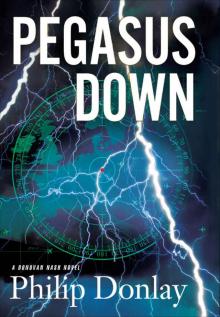 Pegasus Down: A Donovan Nash Thriller (Donovan Nash Thrillers)
Pegasus Down: A Donovan Nash Thriller (Donovan Nash Thrillers)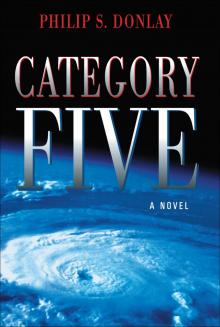 Category Five
Category Five Deadly Echoes
Deadly Echoes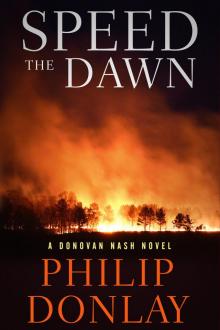 Speed the Dawn
Speed the Dawn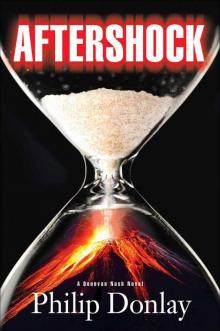 Aftershock: A Donovan Nash Novel (A Donovan Nash Thriller)
Aftershock: A Donovan Nash Novel (A Donovan Nash Thriller)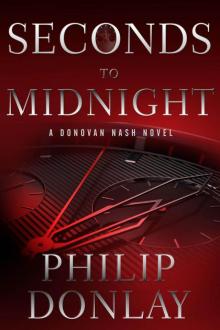 Seconds to Midnight
Seconds to Midnight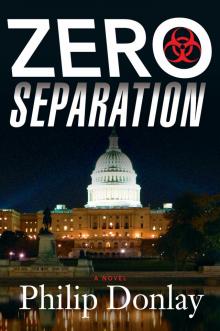 Zero Separation
Zero Separation